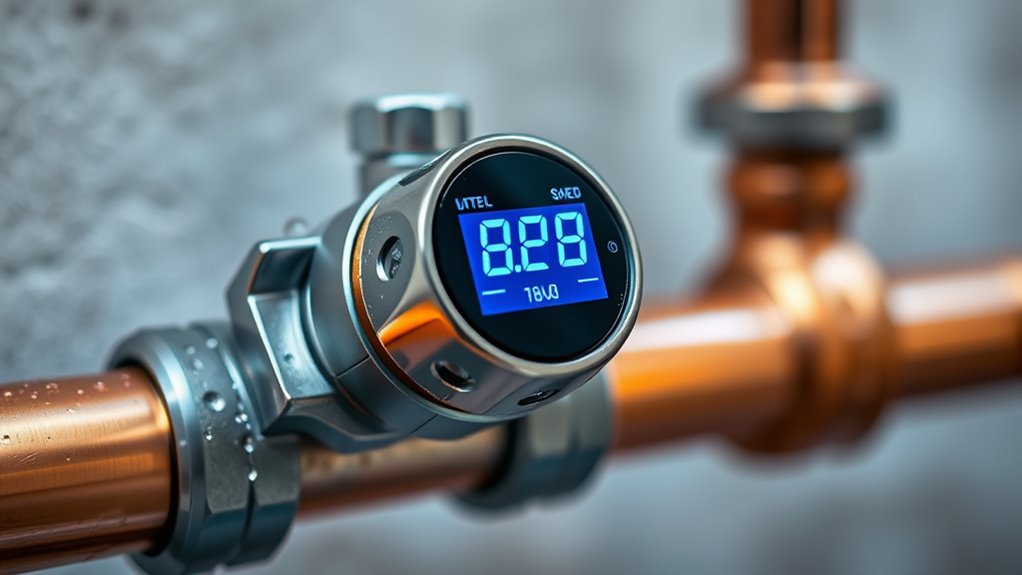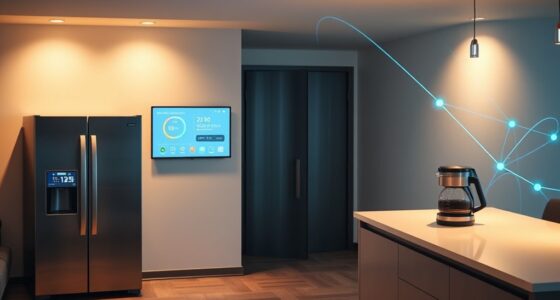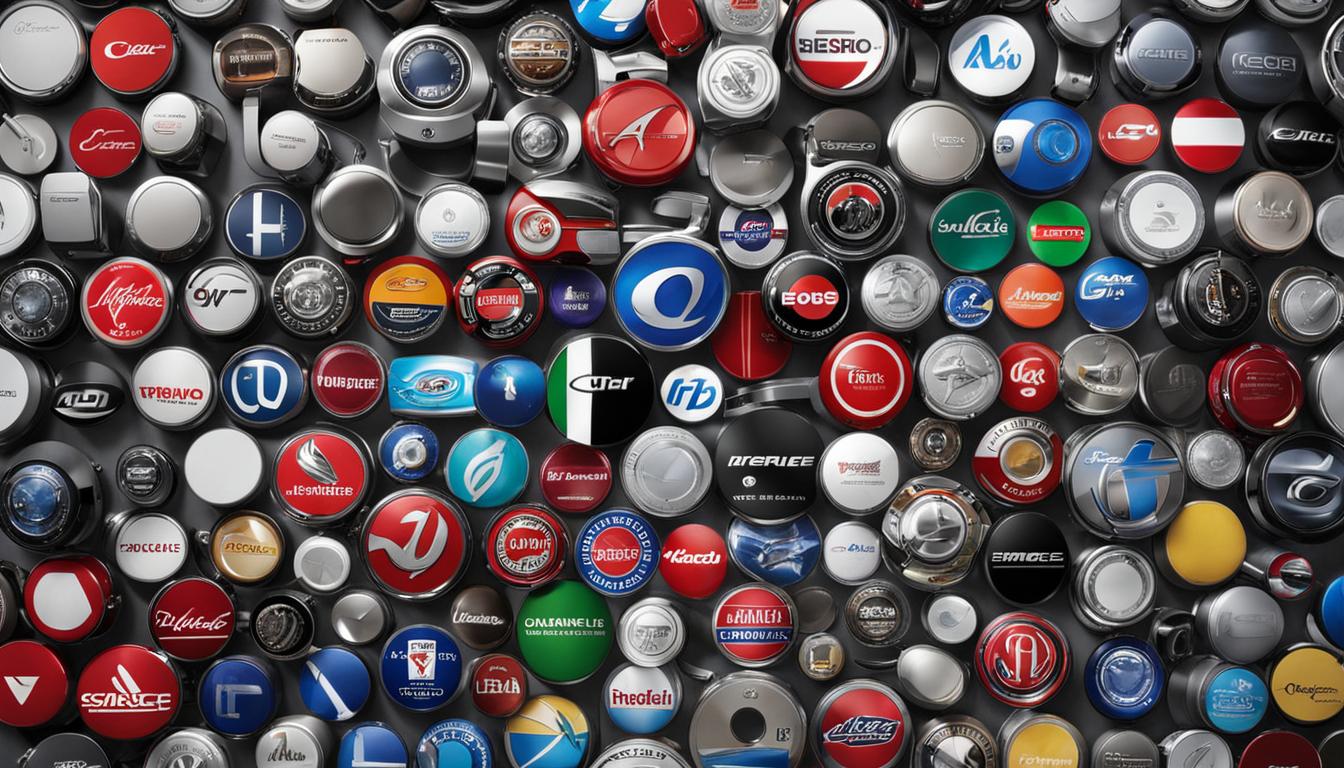Smart leak valves with auto-shutoff detect leaks instantly and stop water flow before extensive damage occurs. They use sensors and AI to monitor water patterns or detect water at specific points, triggering motorized valves that shut off the supply. This quick response prevents flooding, mold growth, and costly repairs. Properly installed and maintained, these systems offer safety, conserve water, and save money. To discover how these solutions work together to protect your property, keep exploring further.
Key Takeaways
- Detect water leaks early using sensors that trigger automatic shutoff valves to stop water flow instantly.
- Continuous water usage monitoring with AI distinguishes between normal use and leaks, enabling timely response.
- Auto-shutoff valves prevent water damage by halting flow before leaks cause structural or property harm.
- Remote monitoring allows homeowners to respond promptly to leaks, reducing exposure and potential damage.
- Proper installation and maintenance ensure reliable leak detection and effective shutoff, minimizing costly water-related damages.
Types of Smart Leak Detection Systems
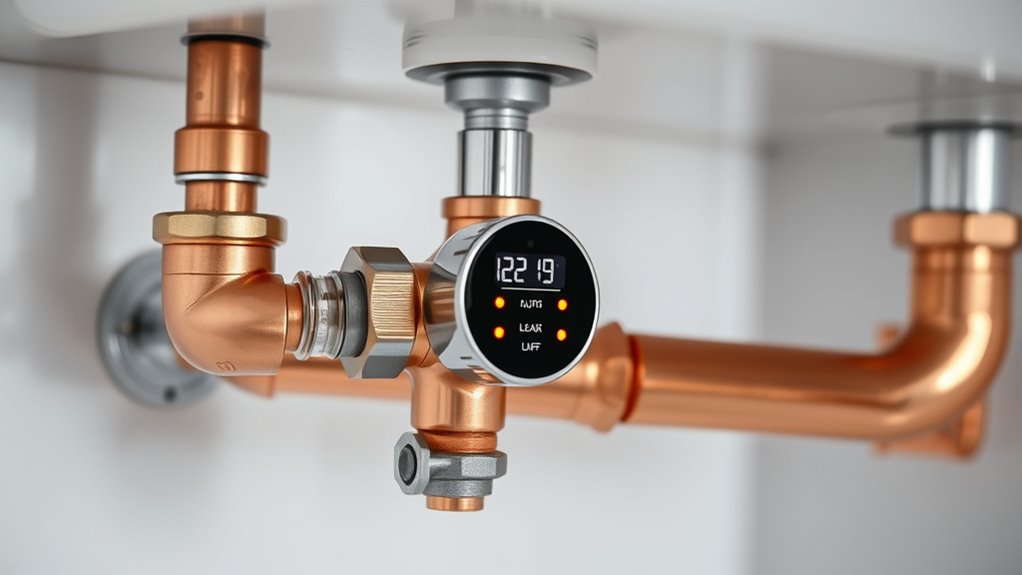
Smart leak detection systems come in various types, each designed to suit different needs and budgets. Flood sensors, also called puck or spot leak sensors, are affordable and easy to install. They detect water presence at specific spots like under sinks or near appliances and send alerts via Wi-Fi to your smartphone or smart home system. These sensors use moisture-sensitive probes or conductive pads but don’t measure flow rates or shut off water automatically. Whole-house leak detection systems monitor your entire plumbing by analyzing water usage patterns with advanced AI. They can automatically activate shutoff valves to prevent damage but cost more and usually need professional installation. Single-point detectors target high-risk areas, offering localized detection at a lower cost, with some supporting automatic shutoff functionality. Incorporating smart leak detection technology can significantly reduce the risk of water damage by providing real-time alerts and automatic responses. Additionally, many systems feature remote monitoring capabilities that allow homeowners to oversee their plumbing health from anywhere.
How Auto-Shutoff Mechanisms Work
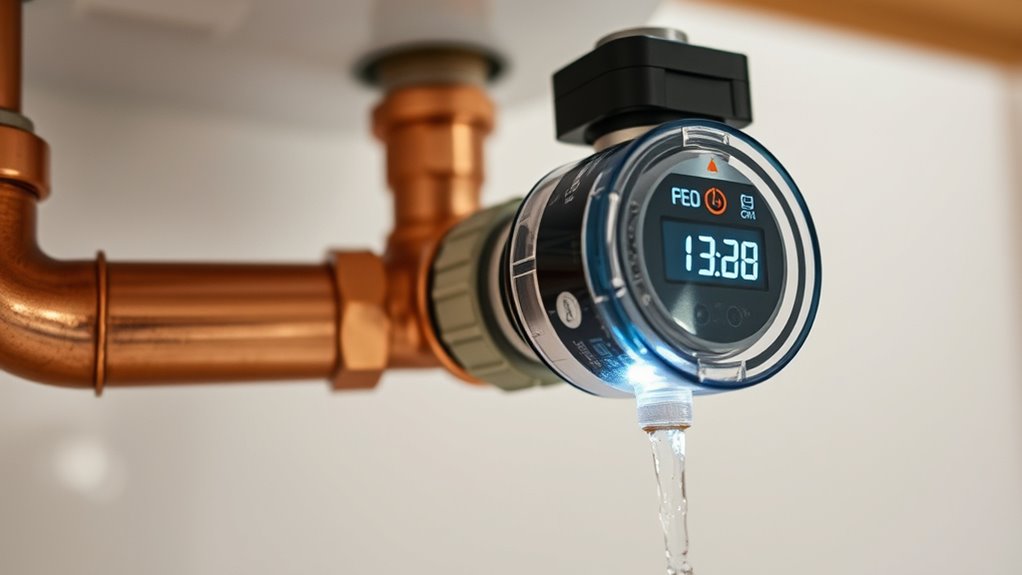
Auto-shutoff mechanisms operate by detecting water leaks and triggering valves to stop the flow immediately. They use various methods, such as point sensors placed in high-risk areas that send wireless signals to close the valve instantly. Valve body activated systems rely on flow rate sensors that monitor water activity, shutting off internally when abnormal flow is detected. Some systems analyze pressure wave signatures to identify leaks precisely and activate the shutoff. Others, like FloSense, learn household water patterns to distinguish leaks from normal use, triggering automatic shutoff during irregular flow. These systems continuously monitor in real-time, ensuring rapid response. Once a leak is detected, a motorized or solenoid valve closes, stopping water supply and preventing damage within seconds to minutes. Leak detection technology continues to advance, improving the accuracy and speed of shutoff responses. Additionally, the integration of smart home systems allows for remote monitoring and alerts, further enhancing leak prevention efforts.
Benefits of Early Leak Detection and Response
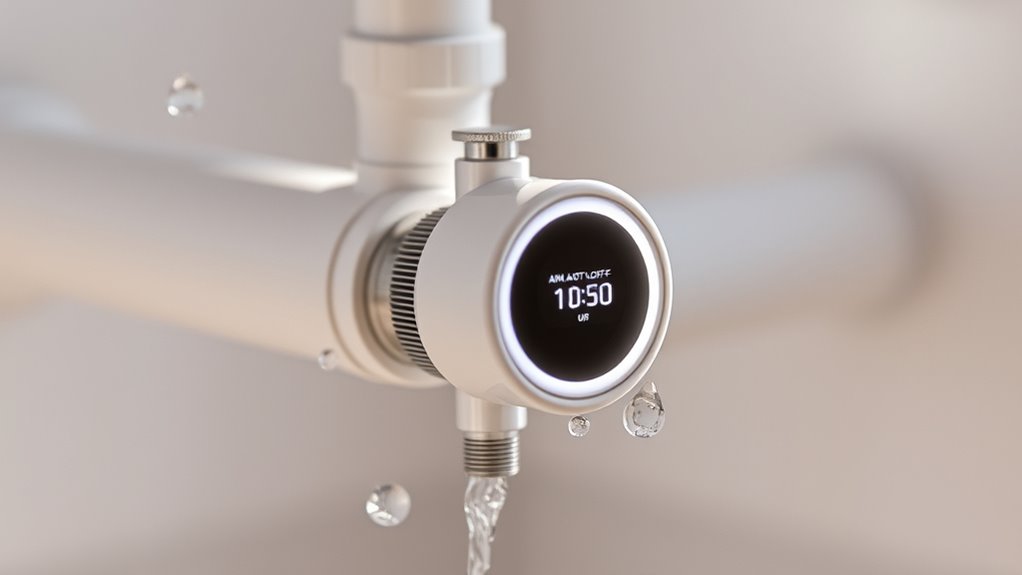
Detecting leaks early helps you prevent significant water damage and costly repairs. When you respond promptly, you save your property from structural issues, mold growth, and extensive restoration costs. Acting quickly also keeps your operations running smoothly and minimizes safety risks. Incorporating advanced leak detection technology can further enhance your ability to identify issues before they escalate. Utilizing smart leak valves with auto-shutoff can automatically stop water flow when a leak is detected, providing immediate protection.
Minimize Water Damage
Early identification of leaks allows you to respond swiftly before they cause significant water damage. Smart leak valves detect issues in real time using sensors that monitor water flow, pressure, temperature, and humidity. AI enhances detection accuracy, flagging abnormal patterns early. Instant alerts enable you to act quickly, preventing leaks from worsening. Automated shutoff valves stop water flow immediately, limiting exposure. This proactive response prevents leaks from spreading to walls, floors, or electrical systems, preserving your property’s integrity. Additionally, preventive maintenance can further reduce the risk of leaks and extend the lifespan of your plumbing system. Implementing smart leak detection technology is a crucial step toward safeguarding your property from water damage. The table below highlights how early detection minimizes damage:
| Benefit | How It Helps | Result |
|---|---|---|
| Rapid leak detection | Alerts you instantly | Limits water exposure |
| Automated shutoff | Stops water flow immediately | Prevents spread of damage |
| Reduced moisture duration | Less mold growth risk | Maintains indoor air quality |
| Damage containment | Protects belongings and structures | Lowers repair costs |
Prevent Costly Repairs
By catching leaks promptly, smart leak valves help you prevent costly plumbing repairs before they escalate. Early detection stops minor issues from turning into major crises that demand extensive repairs. Here’s how they help:
- Detect sudden pressure drops or continuous flow, alerting you to potential leaks instantly.
- Shut off water automatically, preventing pipe bursts, water heater failures, or freezing damage.
- Reduce the need for expensive structural repairs by stopping leaks early.
- Minimize secondary damage like mold growth, which drives up repair costs considerably.
- Properly functioning analytical cookies can improve your overall understanding of appliance performance, helping you identify issues sooner.
- Incorporating smart leak detection technology can enhance your home’s safety by providing real-time leak monitoring and rapid response capabilities.
These proactive measures not only save you money on repairs but also protect your property’s value. Widespread use of smart leak valves results in substantial savings for homeowners and insurers alike, proving that early leak response is a smart investment.
Integration With Home Automation Technologies
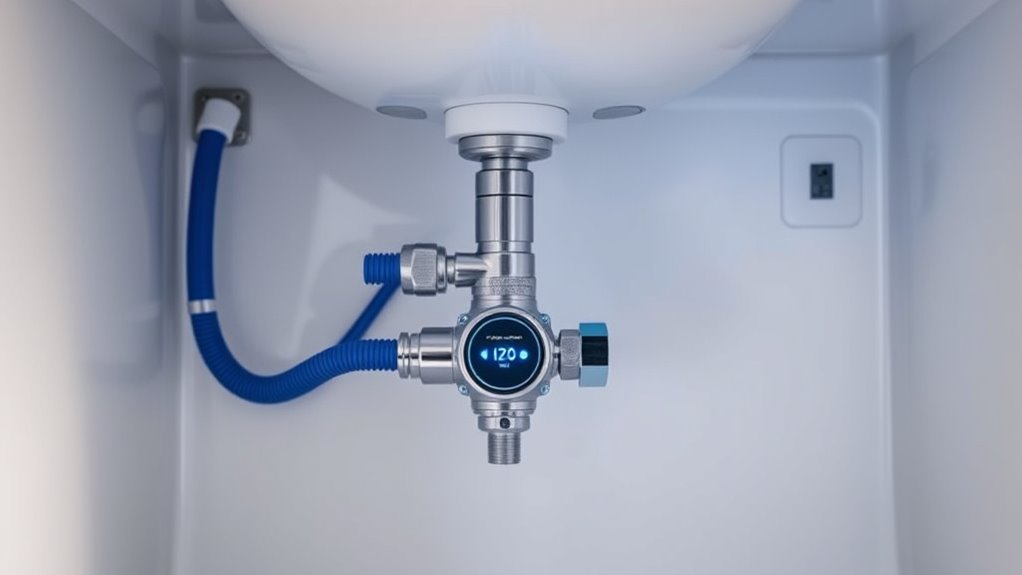
Integrating smart leak valves with home automation technologies allows you to control and monitor water flow seamlessly across various devices and platforms. With compatibility for Apple Home, Alexa, Google Home, and SmartThings, your system responds instantly to leak sensor triggers. Protocols like Zigbee and Matter ensure secure, broad communication. You can connect valves with IFTTT for extended automation options or customize setups via platforms like Home Assistant, enabling real-time water usage tracking and automatic shutoffs triggered by flow anomalies. This integration lets you set manual overrides, automate responses based on leak data, and coordinate with other smart systems. Interoperability standards facilitate seamless communication between diverse devices, enhancing system reliability. Leveraging personality insights can also help tailor your automation routines to fit your preferences and lifestyle. Here’s an overview:
| Ecosystem | Protocols | Automation Capabilities |
|---|---|---|
| Apple Home | Zigbee, Matter | Leak response & custom scenes |
| Alexa/Google | Zigbee, Matter | Voice control & routines |
| SmartThings | Zigbee, Matter | Multi-device integration |
| Home Assistant | Custom APIs | Real-time analytics & alerts |
Installation and Maintenance Considerations
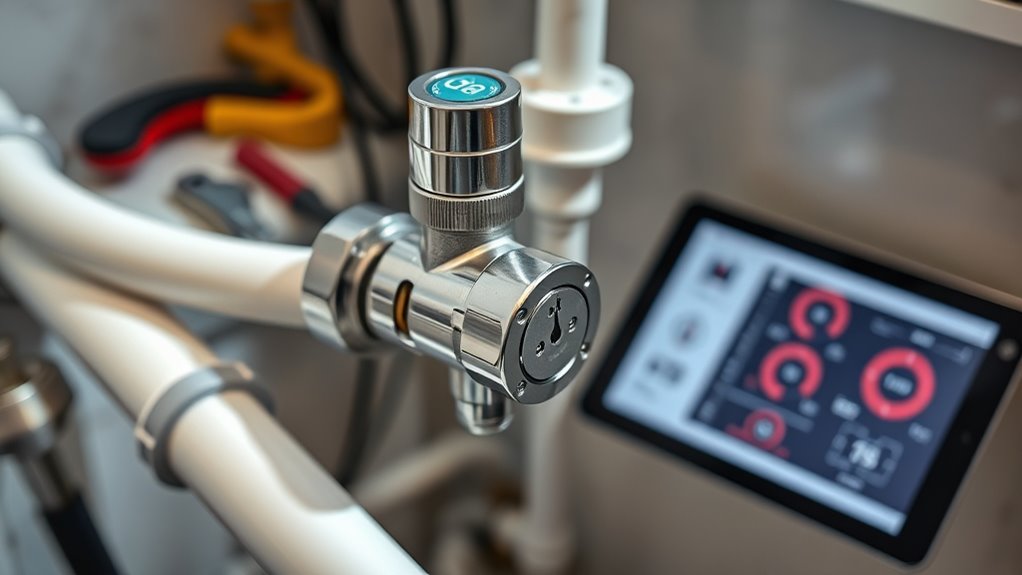
Proper system integration guarantees your smart leak valve operates seamlessly with existing plumbing and automation setups. Regular maintenance practices help catch issues early and keep the device functioning reliably. Staying attentive to these considerations will maximize your system’s performance and longevity. Additionally, consulting professional services can ensure correct installation and ongoing support. Regularly reviewing headphone compatibility and ensuring firmware updates are applied can prevent connectivity issues and prolong device lifespan.
Proper System Integration
To guarantee your smart leak valve functions reliably, careful system integration during installation is essential. First, position the valve after the main shut-off and water meter to ensure proper isolation. Second, keep at least 8 inches clearance from the shut-off valve for fittings and maintenance. Third, orient the valve so the flow arrow points away from the water meter for correct operation. Fourth, connect power sources properly—use the AC outlet as primary and batteries as backup—and ensure Wi-Fi compatibility with a 2.4 GHz network. These steps ensure the valve integrates seamlessly into your system, preventing damage and enabling reliable leak detection. Proper placement, orientation, and power setup are key to maximizing your smart leak valve’s effectiveness and longevity. Additionally, selecting a system with a user-friendly interface can simplify ongoing maintenance and monitoring. Regularly inspecting the system components and understanding system integration principles can further enhance performance and durability.
Regular Maintenance Practices
Regular maintenance of your smart leak valve is essential to guarantee it operates reliably over time. You should regularly inspect the device and pipe connections for signs of wear, leaks, or corrosion. Test its functionality periodically through app diagnostics or manual procedures to ensure it’s working properly. Keep the power supply connections secure and protected from moisture to prevent failures. During maintenance, replace O-rings and seals as needed to maintain a leak-tight system. Always follow local codes and manufacturer guidelines to ensure safety and compliance. Before any work, verify the main water supply is shut off and the system pressure is relieved. Properly clean all connection surfaces and ensure fittings are hand-tightened before final tightening to prevent damage or leaks. Additionally, regularly check for corrosion and wear to extend the lifespan of your system. Incorporating high-tech vaping innovations such as safety alerts can help monitor system health and prevent potential issues proactively.
Challenges and Limitations of Smart Leak Valves
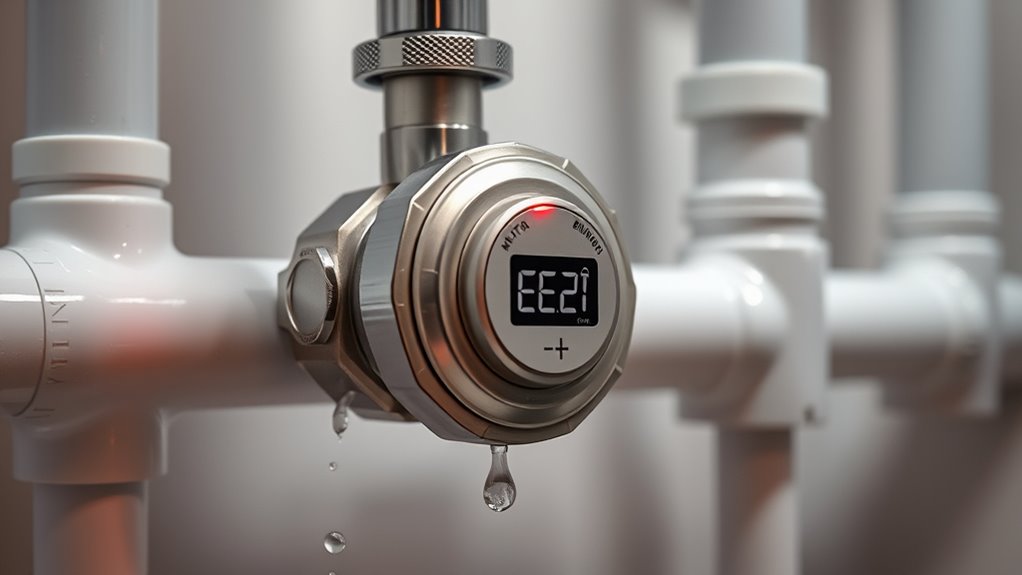
Smart leak valves offer valuable protection against water damage, but they also face significant challenges that can hinder widespread adoption. You might encounter high upfront costs and installation complexity, often needing professional help and custom fittings. Limited sensor coverage can leave some leaks undetected, especially slow or hidden ones. Technical issues like internet dependency and software updates can cause reliability problems, while older plumbing may reduce system effectiveness.
- Expensive initial investment and installation hurdles
- Gaps in leak detection coverage
- Dependence on stable internet and software stability
- Compatibility issues with plumbing and environmental factors
These hurdles can make smart leak systems less accessible or reliable, limiting their effectiveness and acceptance. Understanding these challenges helps you weigh the benefits against potential drawbacks.
Impact on Property Safety and Water Conservation

Implementing smart leak valves with auto-shutoff can substantially boost your property’s safety and help prevent costly water damage. These systems reduce water damage claims by up to 96% and cut claim severity by nearly 72%, saving you thousands of dollars. With early leak detection, you can avoid secondary issues like mold, structural damage, and electrical hazards. The automatic shutoff limits water flow immediately after a leak is detected, minimizing damage and disruption. Remote control options allow you to shut off water from anywhere, adding peace of mind during vacations or emergencies. Additionally, these systems promote water conservation by preventing waste from unnoticed leaks and optimizing usage through customizable schedules. Water waste reduction is an important benefit that supports environmental sustainability. Overall, smart leak valves enhance home safety, reduce environmental impact, and support sustainable living. Sizing and load‑planning tools can help ensure your system is correctly configured for your specific property needs.
Frequently Asked Questions
How Long Does the Battery Last in Smart Leak Valves?
The battery in your smart leak valve typically lasts between 2 to 3 years, depending on usage and environmental factors. You’ll get notifications via your smartphone app when the battery is low, so you can substitute it before it runs out. Some models with longer battery life—up to 15 years—use sealed sensors, but most rely on user-replaceable batteries like CR123A or AAA. Regular checks guarantee your device stays operational.
Can Smart Leak Valves Detect Gas Leaks or Only Water Leaks?
Think of smart leak valves as water guards, only they don’t guard against gas leaks. They’re built specifically to detect water through moisture sensors and shut off the flow to prevent flooding. Gas leaks require different sensors that detect airborne gases like methane or carbon monoxide. So, your smart leak valve can’t spot gas leaks — you’ll need dedicated gas detectors for that. They’re like different sentinels watching over your home’s safety.
Are Smart Leak Valves Compatible With All Types of Plumbing Systems?
Smart leak valves aren’t compatible with all plumbing systems. You need to check their thread sizes and connection types because many require adapters for different pipe materials like copper, PEX, or PVC. Some are designed specifically for standard residential plumbing, while others may need modifications. It’s best to consult a professional to guarantee proper fit and compatibility, especially if your plumbing setup is unique or complex.
What Is the Typical Cost Range for Installing These Systems?
The typical cost to install smart leak valves with auto-shutoff ranges from $100 to $300 for professional installation, depending on system complexity and plumbing conditions. The devices themselves usually cost between $200 and $600 or more. Keep in mind, additional expenses like adapters or wiring may apply. Investing in professional installation guarantees proper setup, maximizing leak detection efficiency and preventing costly water damage, offering peace of mind and long-term savings.
How Secure Are the Data and Remote Access Features of Smart Leak Valves?
Your smart leak valve’s data and remote access features are generally locked down tighter than Fort Knox, thanks to strong encryption, multi-factor authentication, and secure wireless protocols. However, no system is invincible, so it’s essential you keep firmware updated, use secure networks, and manage app permissions carefully. Staying vigilant helps you avoid falling into a trap, ensuring your device remains a safe and reliable line of defense against leaks.
Conclusion
Smart leak valves with auto-shutoff act like vigilant guardians, catching leaks before they cause damage. By integrating advanced detection and quick response, they protect your property and conserve water. Think of them as your home’s first line of defense, silently working behind the scenes. Investing in these systems means peace of mind, knowing you’re preventing costly repairs. With smart leak valves, you stay ahead of trouble, just like a watchful eye that never sleeps.
